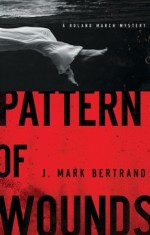Diehard crime procedural fans were enthralled with J. Mark Bertrand’s brittle and dangerous
picture of the life of a homicide detective in modern-day Houston. Through the eyes of the
unforgettable yet broken Roland March, Bertrand deftly navigated readers through a chilling
mystery full of complexity and clever clues. That was
Back on Murder.
Now with Pattern of Wounds, Bertrand returns with another haunting case that solidifies his
right to be grouped with such reader favorites as Steven James, Michael Connelly, and Tim
Downs. Having survived one of his darkest hours, and with a reputation only gingerly repaired,
March must continue to put back together the pieces of his life, as well as the clues of an old
case, when new evidence suggests he put the wrong man behind bars.
Q: What led you to write Pattern of Wounds?
All my Roland March crime novels center around some cultural obsession of
ours. In the first book, Back on Murder, it was the phenomenon that’s been
dubbed “missing white girl syndrome.” The second March novel, Pattern of
Wounds, explores our serial killer obsession. What is the appeal of serial killers?
They seem to impart order and even a twisted kind of meaning to the
randomness of murder.
Q: How did the story develop?
It all started with a single character, Tammy Putnam, whose brother went missing
as a young teen decades ago. Now her life is devoted to a campaign to reclassify
her brother as one of the victims of a serial killer who terrorized Houston in the
1970s. She’s obsessed with this, because she thinks getting his name on that list
will somehow give her brother’s death meaning. This woman’s need to see her
brother as a serial killer’s victim inspired the book’s preoccupation with patterns,
hidden meaning, and so on.
Q: Did this book challenge you more as a writer than Back on Murder did?
Part of Roland March’s fame as a homicide detective derives from a true crime
book written about his first big case, Brad Templeton’s The Kingwood Killing. This
imaginary book-within-a-book is mentioned in Back on Murder, but as Pattern
of Wounds progresses, it becomes central to the plot. March’s famous conviction
is starting to unravel in a big way. As an author, I was faced with a challenge: how
could I write about this imaginary book and keep the details straight? There was
only one answer: I had to write it. So in addition to Pattern of Wounds, I found
myself writing a set of excerpts from Brad Templeton’s The Kingwood Killing––
and the styles couldn’t be more different. Templeton is a journalist, recording
March’s adventures in an objective — if somewhat sensational — narrative. In the
end it was a lot of fun, and readers who want to dig deeper into the plot can read
The Kingwood Killing online.
Q: What is Pattern of Wounds really dealing with at its core?
Pattern of Wounds is about the face of evil and our desire to personalize tragedy,
in particular our need to place the blame. It’s also about the way we impose order
on seemingly unrelated events––in this case, a series of brutal murders over the
course of a decade.


